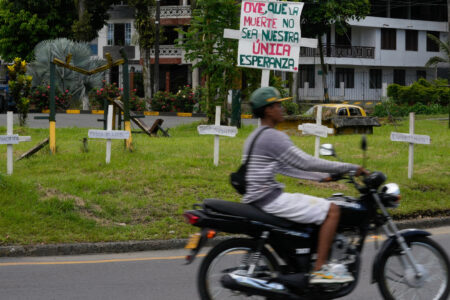
In the wake of the anti-Black racism protests that rocked the world, Canadian governments — at the federal, provincial and municipal levels — are beginning to consider policy reforms to address systemic racism. The scope of suggested reforms has been limited, focusing primarily on policing. While this is certainly a necessary step, it is not enough. To impactfully reduce systemic racism in Canada, governments will have to reform the broader criminal justice system (not just policing) as well as address the socio-economic conditions that disproportionately lead to the criminalization of racialized communities, known as the “social determinants of justice.”
In October 2018, the Institute for Research on Public Policy (IRPP) published a report commissioned by the Department of Justice Canada titled Rethinking Criminal Justice in Canada, which summarized the insights from four round tables held around the country. These consultations brought together 55 academics, community leaders, social policy experts, jurists and other actors to define the issues in the criminal justice system and provide recommendations on how they can be resolved.
The report identifies five social factors that lead to negative justice outcomes: income, employment, stable housing, education and health. It dubbed them collectively the “social determinants of justice,” drawing on the similar concept of « social determinants of health.” Those who fare poorly by these measures are commonly referred to as « at risk » because they are more likely to engage in activities or to suffer from precarious circumstances that will lead them to encounters with the police.
As figures 1 to 5 show, Black and Indigenous people are significantly worse off than white Canadians on all five social factors. Note that the word “white” is used in some of the figures in this article to denote Canadians who are neither members of visible minority groups nor Indigenous. In other figures, “non-visible-minority” is used, a category that includes white and Indigenous persons.
Criminalizing poverty
Canada has an established pattern of criminalizing poverty. Criminalization is used to quell problems that are fundamentally social: the lack of assistance for those living with mental illness, for example. Indigenous and Black Canadians are especially affected by this pattern.
For example, homeless people are criminalized for seeking many of the things they need to survive, such as loitering, panhandling or sleeping on a park bench. The police are also frequently called to respond to mental-health-related situations, too often leading to tragic consequences in cases like the deaths of Andrew Loku, D’Andre Campbell, Regis Korchinski-Paquet and Ejaz Choudry.
The coexistence of poor social determinants and policing is by no means random. Canadian governments have banned — or been complicit in maintaining bans on — activities predominantly engaged in by Canada’s poor and vulnerable, empowering the police and the criminal justice system to keep them out of sight and out of mind. Other bans for more generalized behaviour, such as the possession of cannabis, have disproportionately affected Indigenous and Black Canadians.
An example among many is Ontario’s Safe Streets Act, which bans “soliciting in an aggressive manner” and endows police with the power to arrest any individual without a warrant. The vague language of the ban gives police officers broad discretion in its application. The consequence of this Act has been the criminalization of subsistence strategies such as panhandling, busking and squeegeeing, which are predominantly employed by low-income and homeless Ontarians. They are then charged fines that they can’t pay, which leads to even more interactions with the justice system.
There should be no debate that Indigenous and Black Canadians are disproportionately affected by poor social determinants of justice. To make matters worse, systemic targeting, racial profiling, unnecessary violence committed against racialized communities by the police and the Canadian justice system more broadly further contribute to the worsening of these determinants. White Canadians can certainly have poor social determinants of justice, which makes them more likely to interact with the criminal justice system than their more affluent and less vulnerable counterparts. However, the most important distinction is that the criminal justice system does not target them. In fact, as figures 6 to 9 show, they are far less likely to come into contact with the system.
Racially disaggregated data are generally sparse in Canada, but especially so with regard to policing and criminal justice. The limited data available have come from independent investigations or from freedom of information requests by assiduous journalists. There is hope for higher-quality data in the future: Statistics Canada and the Canadian Association of Chiefs of Police have recently signed a joint statement committing to work with key organizations to enable police to report crime statistics on Indigenous and ethno-cultural groups.
The social consequences: A vicious cycle of impoverishment
The targeting of racialized communities by the Canadian criminal justice system has had severe generational and cyclical consequences for their collective social determinants of justice, reducing their quality of life and limiting their opportunities for upward mobility. Herein lies a vicious cycle: poor social determinants increase the risk of interaction with the criminal justice system, and interaction with the system constrains the ability to improve these social determinants, often actively worsening them. Even a brief encounter such as a street check can have lasting effects, such as trauma, an increased feeling of violation or decreased trust.
Once an individual has a criminal record, even for a short sentence, they face significant barriers to reintegrate into society. Released offenders face discrimination in seeking housing and on the job market, with unemployment rates of more than 40 percent. This results in a lower income, difficulty finding stable housing and potential health concerns such as decreased nutrition, mental health issues or addiction. This can worsen their social determinants of justice and lead them to rely on more criminalized behaviour as a form of subsistence. In 2011-12, the two-year post-release reoffending rate was 23.4 percent, and 37.7 percent for Indigenous men.
There is also evidence of a revolving door between homelessness and prison. A 2010 Toronto-based study showed that about 20 percent of the incarcerated population had been homeless, and over 32 percent expect to be homeless upon release.
When an individual comes into contact with the criminal justice system, it doesn’t affect just them, it has a considerable effect on their family as well. There is a lot of social stigma in incarceration, and families of offenders become ostracized at a time when they need the most support. They are also likely losing a breadwinner, while experiencing increased financial strain from costs associated with incarceration such as visitation, phone calls or sending money for in-prison needs. And even when the family member is released, it is improbable that their situation will improve, due to the limited employment potential for ex-offenders. As a result, the family’s income is reduced, rent is harder to pay, health outcomes decline and the education of the children is adversely affected. The social determinants of justice of the family as a whole worsen. In fact, there is evidence that the incarceration of a parent is part of a cycle that produces second-generation offenders with even worse outcomes than the first generation.
When we disproportionately invest in policing, we invest in the continued cycle of incarceration and impoverishment of racialized communities. Investments in social services, on the other hand, would actively improve their social determinants of justice. Attempts to improve the system as it stands have failed. To eradicate systemic racism, policing and criminal justice don’t just need to change, they need a paradigm shift.
Photo: Police keep an eye on protesters during a demonstration calling for justice for the death of George Floyd and all victims of police brutality, in Montreal on June 7, 2020. THE CANADIAN PRESS/Graham Hughes








